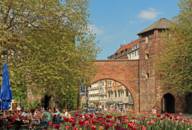
Sendlinger Tor gate is one of the last remaining pieces of Munich’s city wall – it has surrounded the Altstadt since the 15th century. Today, it is one of the most important hubs in the city centre.
The second of Munich’s city walls was almost completely demolished during the 19th century; all that remained were a fragment on Jungfernturmstrasse near the Literaturhaus and Isartor as well as the respective outer gates of Sendlinger Tor and Karlstor. Thus, Sendlinger Tor gate is one of just three remaining city gates in Munich that can still be viewed today.
The first written record of the gate dates from 1318 – at that time, it was the starting point for those journeying towards Italy. The gate structure itself was built during the 15th century, however, as Sendling (then a village, but now a district of Munich) began to increase in importance. The working-class district expanded and its population continued to grow, eventually resulting in the need for a city gate to the south of Munich.
Sendlinger Tor changed constantly over the centuries – until 1808, it had the middle tower that was typical of most city gates, and until 1906 it also featured three small archways for people to pass through, which were then converted to one large arch by architect Wilhelm Bertsch. Fortunately, the southern city gate emerged from the Second World War largely unscathed, and last underwent general renovations during the 1980s. The gate also lends its name to the neighbouring Sendlinger-Tor-Platz (Sendlinger Tor Square). The Filmtheater Sendlinger Tor, which opened in 1913 and is one of the oldest cinemas in Munich, is another important institution in the city.